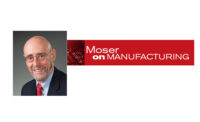For the past several years, the Reshoring Initiative has been helping manufacturers reshore production or keep existing work here through total cost of ownership (TCO) analysis. However, calculating TCO is only part of the overall competitiveness equation.
Manufacturers should also take a hard look at the cost of their products. By applying the principles of design for manufacture and assembly (DFMA)—especially early in the design stage—companies can significantly reduce the cost of their products to make them more competitive with cheaper imports. By designing parts so they are easier to make and assemble, manufacturers can increase throughput, reduce inventories, improve quality, and lower warranty costs.
One manufacturer that has done just that is Dynisco. Based in Franklin, MA, Dynisco makes pressure sensors, rheometers and other equipment for the plastics industry. Matt Miles, DFMA and value engineering manager at Dynisco, used both TCO and DFMA analyses to see if offshoring made sense for his company.
Miles used TCO analysis to quantify the obvious costs of offshoring, such as shipping, and the hidden costs, such as inventory carrying costs, travel and intellectual property theft. At the same time, he used DFMA analysis to simplify Dynisco’s product designs and reduce their cost. Through these analyses, Dynisco found that keeping production in the U.S. offered an 8 percent total cost advantage vs. making the products offshore!
One of my favorite redesign success stories is when GE invested $800 million in a Kentucky factory to reshore production of water heaters, refrigerators and washing machines, creating 1,300 jobs. To maximize savings, GE completely redesigned its water heater. Due to the ease of design collaboration resulting from the close proximity of the engineering and manufacturing workforces, GE was able to simplify the product to the extent that the retail price of some U.S.-made heaters was 20 percent lower than for the imports those products replaced. The Chinese product was 30 percent lower based on the ex-works price, but 6 percent higher when logistics, inventory costs and delivery problems were added into the mix.
Toyota recently began collaborating more closely with its suppliers by moving them into its expanded North American R&D Center in York Township, MI. The automaker is also bringing suppliers into the planning stage as much as two years earlier. Previously, engineers might interact with suppliers only monthly and often by phone. The close proximity and deeper advanced planning enables feedback in real time, clearer communication, cost and cycle time reduction, and improved quality by spotting potential problems earlier when issues are easier to fix.
The Reshoring Initiative has found that many manufacturers cite “product redesign” as one of their top reasons for being able to reshore production or to not offshore in the first place. Here are some more examples:
- Tesla is reshoring battery production from Japan to its Gigafactory in Nevada to cut costs and optimize production through redesign, innovative manufacturing, waste reduction, and locating most manufacturing processes under one roof.
- Boeing reshored manufacturing and redesigned parts when battery problems in its 787s led the FAA to ground the entire fleet in early 2013. The problems were related, in part, to flawed offshoring decisions and quality issues.
- Pace Industries, a diversified die-casting company, opted to keep manufacturing in the U.S. so it could be more responsive to customers and take better advantage of the expertise of local suppliers. A series of process improvements helped the company increase profit margins.
Through TCO analysis, part redesign and process innovation, we can reshore more manufacturing and keep jobs here in the U.S.

